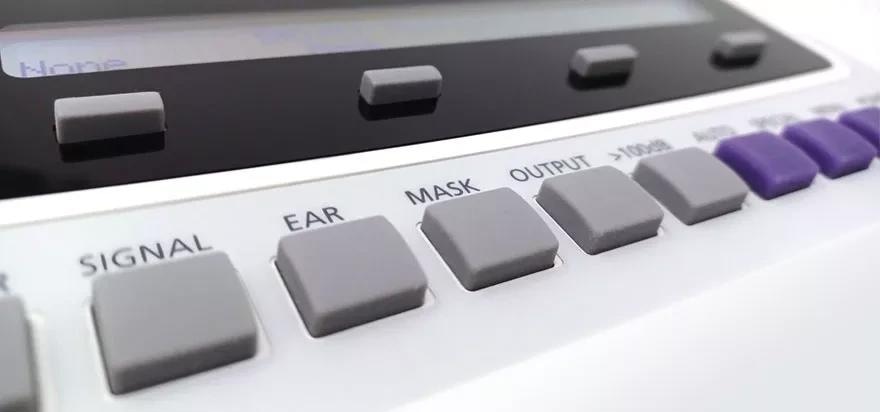During audiometric testing, pure-tone stimuli at a range of frequencies and intensities are played to the listener. If, however, a stimulus to one ear is loud enough, it can cross through the head or radiate out to the opposite ear.

Image Credit: Amplivox UK
This presents difficulties, as the patient might respond to the accidental stimulation of the non-test ear, resulting in the stored threshold being better than it would be if the signal came from its intended destination.
Audiometric masking is utilized to prevent this from happening. It is a technique used during hearing tests to ensure that hearing thresholds are accurately measured.
Why is audiometric masking used?
The primary goal of audiometric masking is to make sure the listener is only responding to the stimuli in the test ear and not to the signal that crosses over to the non-test ear. This is achieved by introducing a noise or tone in the non-test ear, preventing it from detecting any of the signal that crosses over.
This leads to reliable and accurate test results since the masking noise is emitted at an intensity sufficient to mask the crossing over of sounds, but low enough that it allows the listener to hear the test stimulus.
When to use audiometric masking
Masking is essential when the difference between unmasked air conduction thresholds exceeds 40 dB while using supra-aural headphones, or 55 dB if using insert headphones. These values correspond to a transducer’s associated Interaural Attenuation (IA) value.
IA is the amount of signal loss caused by a stimulus traveling through a medium, which, in this case, would be the patients’ heads. Since supra-aural headphones are a large speaker, the IA value is lower. This is because less energy is being lost by this traveling signal.
The interaural attenuation value of bone conduction transducers is 0 dB, and it can be assumed that the best hearing cochlea elicits a non-masked response, as both cochleae are stimulated equally.
Clinicians are urged to follow masking guidelines that have been provided by their local authority for audiology procedures such as audiometry. These often recommend how masking should be applied according to different regulations. It is recommended that this information is sought in accordance with your location, as guidance can vary.
How to perform audiometric masking
This is the basic procedure for audiometric masking:
- Clarify the objective of masking: audiometric masking is only necessary when the sound presented to one ear might interfere with the listener’s ability to hear sounds presented to the other ear. This generally occurs when the hearing threshold of the listener is substantially better in one ear than the other.
- Select the appropriate masking signal: the masking noise should be opted to mimic the frequency of the target stimulus as accurately as possible. This is usually a narrowband noise for pure tone stimuli.
- Determine the level of masking: the masking level needs to be the minimum required to mask the interfering sound without hindering the patient’s ability to hear the target stimulus in the test ear.
- Initiate the test stimulus: once the masking level has been selected, the test stimulus can be introduced to the patient in the ear being tested. The patient should be directed to focus on the stimulus and not the masking noise.
- Identify the threshold and increase masking noise: the test stimulus should be altered until the threshold is found (which may vary during the masking procedure). Increase the masking noise to find a plateau, which will allow accurate measurement of the listener’s hearing threshold.
Audiometric masking should only be performed by a hearing healthcare professional or a trained audiologist to ensure accurate and safe testing.
Diagnostic audiometer with masking
The Model 270+ audiometer is a powerful two-channel diagnostic tool that uses enhanced technology to provide a more efficient and accurate testing experience.
This device provides completely accurate measurements, boasting an integrated masking assistant function that updates the operator when to apply masking levels while evaluating the volume of the stimulus as either ideal, too soft, or too loud.
Upon requirement, the Model 270+ can be set to automated testing mode, in which it applies masking levels automatically, for both air conduction (AC) and bone conduction (BC).
About Amplivox
Amplivox creates a healthier future by providing accessible and accurate medical solutions for everyone.
As a manufacturer with more than 90 years of experience, we are proud to be a trusted partner to hearing and occupational health professionals all over the world by delivering a high level of knowledge-led solutions, service and support. We are here to be your preferred audiological and occupational health equipment provider.
Sponsored Content Policy: News-Medical.net publishes articles and related content that may be derived from sources where we have existing commercial relationships, provided such content adds value to the core editorial ethos of News-Medical.Net which is to educate and inform site visitors interested in medical research, science, medical devices and treatments.